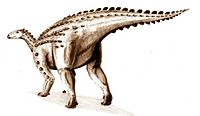Sinemurian
Template:Jurassic In the geologic timescale, the Sinemurian is an age or stage in the Early or Lower Jurassic epoch or series. It spans the time between 199.3 ± 2 Ma and 190.8 ± 1.5 Ma (million years ago).[1] The Sinemurian is preceded by the Hettangian and is followed by the Pliensbachian.[2]
In Europe the Sinemurian age, together with the Hettangian age, saw the deposition of the lower Lias, in Great Britain known as the Blue Lias.
Stratigraphic definitions

The Sinemurian stage was defined and introduced into scientific literature by French palaeontologist Alcide d'Orbigny in 1842. It takes its name from the French town of Semur-en-Auxois, near Dijon. The calcareous soil formed from the Jurassic limestone of the region is in part responsible for the character of the classic Sancerre wines.
The base of the Sinemurian stage is at the first appearance of the ammonite genera Vermiceras and Metophioceras in the stratigraphic record. A global reference profile (GSSP or golden spike) for the Sinemurian stage is located in a cliff north of the hamlet of East Quantoxhead, 6 kilometres east of Watchet, Somerset, England.[3]
The top of the Sinemurian (the base of the Pliensbachian) is at the first appearances of the ammonite species Bifericeras donovani and ammonite genus Apoderoceras.
The Sinemurian contains six ammonite biozones in the Tethys domain:
- zone of Echioceras raricostatum
- zone of Oxynotoceras oxynotum
- zone of Caenisites turneri
- zone of Arnioceras semicostatum
- zone of Arietites bucklandi
Palaeontology
†Ichthyosaurs
| Ichthyosauria of the Sinemurian | ||||
|---|---|---|---|---|
| Taxa | Presence | Location | Description | Images |
| From Hettangian to Sinemurian | Belgium, England, Germany | Among the best known ichthyosaur genera, was smaller than most of its relatives, measuring 2 m (6 ft 7 in) in length. |  | |
Mammaliaformes
| Mammaliaformes of the Sinemurian | ||||
|---|---|---|---|---|
| Taxa | Presence | Location | Description | Images |
| Yunnan, China | The earliest known example of several features distinctive to mammals, including mammal-like mandible and middle-ear structures and a relatively large brain cavity. | |||
| From Norian to Sinemurian | Greenland and Western Europe | A Late Triassic-Early Jurassic symmetrodontan. | ||
†Ornithischians
| Ornithischians of the Sinemurian | ||||
|---|---|---|---|---|
| Taxa | Presence | Location | Description | Images |
| From Hettangian to Sinemurian | Upper Elliot Formation, Lesotho and Cape Province, South Africa | Considered the most basal member of the family Heterodontosauridae |   | |
| From Hettangian to Sinemurian | Lesotho | As the only fossil known of it is a partial jawbone with three teeth, Fabrosaurus is a nomen dubium and may in fact be the same as Lesothosaurus. | ||
| Clarence Formation, Cape Province, South Africa | With few remains, it is considered a nomen dubium. It is classified as an ornithischian based on the jaw. | |||
| From Hettangian to Sinemurian | Upper Elliot Formation, Orange Free State, South Africa | A heterodontosaurid ornithischian | ||
| Dated disputed | Unknown location in Portugal | Only known from a partial snout with teeth | ||
| From Hettangian to Sinemurian | Upper Elliot Formation, Cape Province, South Africa | A small herbivore dinosaur despite long canines it sported in its jaws; due to this unique characteristic it is very clearly allied to Heterodontosaurus | ||
| England | Disputed, considered by some to be a tetanuran theropod | |||
| From Hettangian to Sinemurian | Charmouth, West Dorset, England; Kayenta Formation, Arizona, USA | A genus of quadrupedal, lightly plated, herbivorous dinosaur about 4 meters (13 feet) long | ||
| From Hettangian to Sinemurian | Stormberg Series Formations, South Africa, Lesotho | A primitive ornithischian, about 2 meters (6 feet 7 inches) long. The proportions of the posterior limbs show differences with those of Lesothosaurus, and reveal a lower ability to run | ||
†Plesiosaurs
| Plesiosauria of the Sinemurian | ||||
|---|---|---|---|---|
| Taxa | Presence | Location | Description | Images |
| Granby, Leicestershire, England | May have been a rhomaleosaurid, pliosaurid or elasmosaurid |  | ||
|
Sinemurian and Toarcian | Lyme Regis, Dorset, England | A large (about 3 to 5 meters long), marine sauropterygian reptile, it was distinguished by its small head, long and slender neck, broad turtle like body, a short tail, and two pairs of large, elongated paddles | |
Theropoda
| Theropods of the Sinemurian | ||||
|---|---|---|---|---|
| Taxa | Presence | Location | Description | Images |
| Sinemurian to Pliensbachian | Arizona, USA; Yunnan, China | Measured around six meters (20 ft) long and may have weighed half a ton. The most distinctive characteristic of Dilophosaurus is the pair of rounded crests on its skull, possibly used for display. |  | |
| Sinemurian | Leicestershire, England | Measured around 3.5 meters (11 feet) long. The most distinctive characteristic of Sarcosaurus is its pelvis which is remarkably similar to the later Ceratosaurus. | ||
| Sinemurian | Saltrio, Northern Italy | |||
References
- ^ Benton, Michael J. (2012). Prehistoric Life. Edinburgh, Scotland: Dorling Kindersley. pp. 44–45. ISBN 978-0-7566-9910-9.
- ^ For a detailed geologic timescale see Gradstein et al. (2004)
- ^ See for the description of the GSSP Bloos & Page (2001)
Sources
- Bloos, G. & Page, K.N.; 2001: Global Stratotype Section and Point for base of the Sinemurian Stage (Lower Jurassic), Episodes 25(1), pp. 22–28, PDF
- Gradstein, F.M.; Ogg, J.G. & Smith, A.G.; 2004: A Geologic Time Scale 2004, Cambridge University Press.
- d´Orbigny, A.C.V.M.D.; 1842: Paléontologie française. 1. Terrains oolitiques ou jurassiques, Bertrand, Paris. Template:Fr
See also
External links
- GeoWhen Database - Sinemurian
- Lower Jurassic timescale, at the website of the subcommission for stratigraphic information of the ICS
- Stratigraphic chart of the Lower Jurassic, at the website of Norges Network of offshore records of geology and stratigraphy
